Exploring the Potential and Obstacles of Agro-Industrial Waste-Based Fertilizers
Abstract
1. Introduction
2. Materials and Methods
2.1. Raw Materials
2.2. Procedure for Compost Production
2.3. Chemical Analysis of Compost
2.4. Analysis of Soil and Treatments
2.5. Environmental Impact Assessment
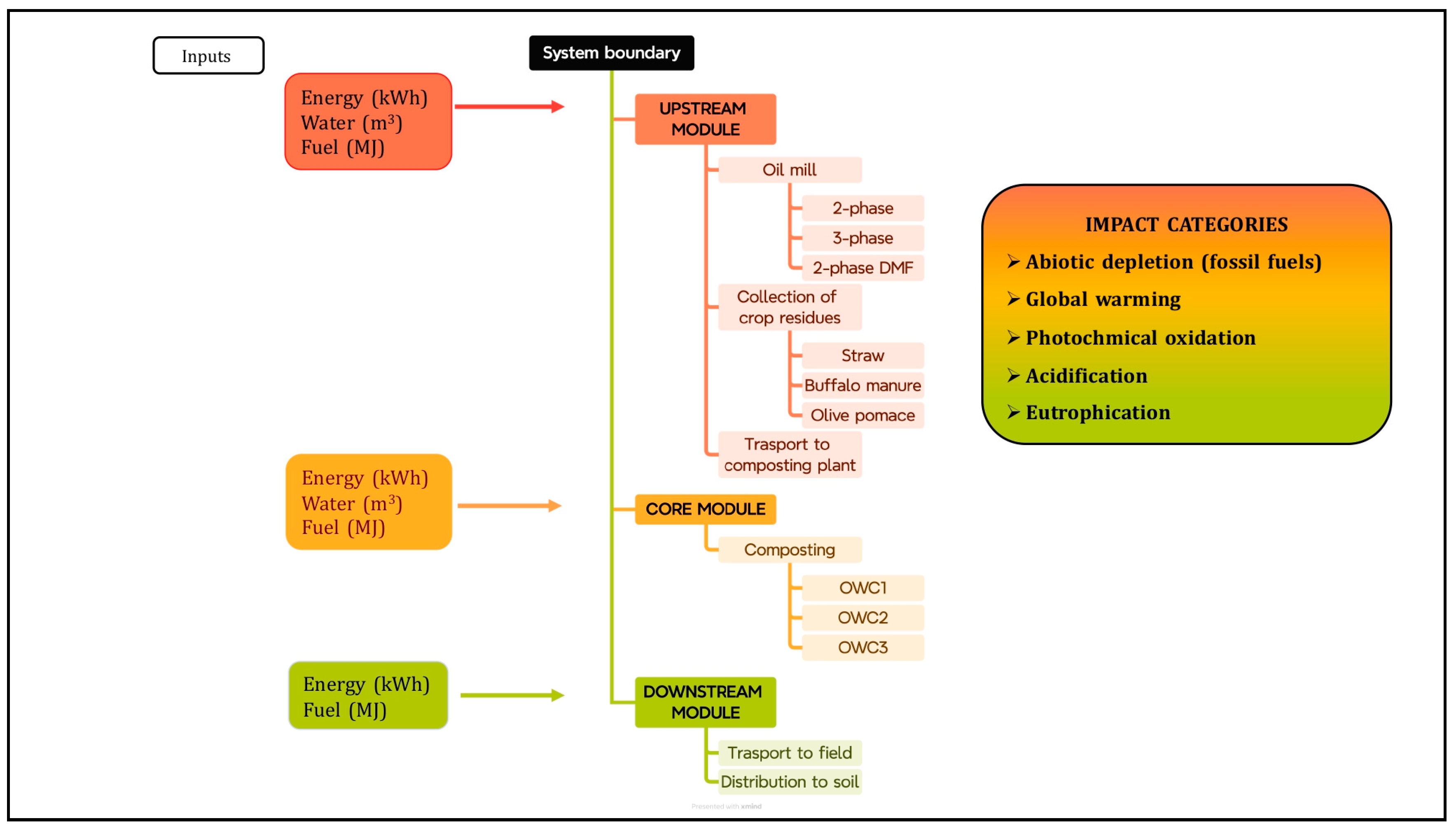
- OWC1: Motta San Giovanni farm, Motta San Giovanni Reggio Calabria, Italy;
- OWC2: Mediterranea Foods Farm, Rizziconi, Reggio Calabria, Italy;
- OWC3: Nuovo Cilento farm in San Mauro Cilento, Salerno (SA), Italy.
- –
- Abiotic Depletion: This category focuses on the impact of mineral and fossil fuel extraction on human health and ecosystems. The abiotic depletion factor, calculated for each extraction, reflects the decreasing availability of these non-renewable resources. This global indicator is based on reserve concentrations and depletion rates.
- –
- Acidification: Acidifying substances negatively affect soil, groundwater, surface water, organisms, ecosystems, and materials. The impact of acidification is measured in sulfur dioxide (SO2) equivalent per kilogram of emissions. This category is relevant on both local and global scales.
- –
- Eutrophication: Eutrophication results from excessive levels of nitrogen dioxide (NO2), and phosphate ions (PO34−) and other nutrients in the environment, leading to increased production of plankton, algae, and aquatic plants. Is measured in PO4 equivalent per kilogram of emission.
- –
- Global Warming Potential: Greenhouse gas emissions contribute to climate change, impacting ecosystem health, human health, and material welfare. The Intergovernmental Panel on Climate Change (IPCC) developed a model to measure the global warming potential (GWP) over a 100-year period, expressed in kilograms of carbon dioxide (CO2) equivalent per emission.
- –
- Photochemical Oxidation: Photochemical ozone formation, a significant air pollution issue, occurs in urban areas with stagnant air and low humidity. This secondary pollutant results from complex photochemical reactions involving sunlight, nitrogen oxides (NOx), and volatile organic compounds (VOCs). Mainly produced by combustion engines and organic solvent use, photochemical ozone is also known as summer smog and is expressed in kilograms of ethylene equivalents.
2.6. Statistical Analysis
3. Results
3.1. Compost Characteristics
3.2. Compost Effects on Soil
3.3. Environmental Impact
4. Discussion
5. Conclusions
Author Contributions
Funding
Data Availability Statement
Conflicts of Interest
References
- Farnia, A.; Hassanpour, K. Comparison between effect of chemical and biological fertilizers on yield and yield components of wheat (Triticum aestivum L.) Pishtaz cultivar. Indian J. Sci. 2015, 5, 7792–7808. [Google Scholar]
- Mariyam, S.; Upadhyay, S.K.; Chakraborty, K.; Verma, K.K.; Duhan, J.S.; Muneer, S.; Meena, M.; Sharma, R.K.; Ghodake, G.; Seth, C.S. Nanotechnology, a frontier in agricultural science, a novel approach in abiotic stress management and convergence with new age medicine-A review. Sci. Total Environ. 2024, 912, 169097. [Google Scholar] [CrossRef]
- Ferreira, C.S.S.; Seifollahi-Aghmiuni, S.; Destouni, G.; Ghajarnia, N.; Kalantari, Z. Soil degradation in the European Mediterranean region: Processes, status and consequences. Sci. Total Environ. 2022, 805, 150106. [Google Scholar] [CrossRef] [PubMed]
- Haddaway, N.R.; Hedlund, K.; Jackson, L.E.; Kätterer, T.; Lugato, E.; Thomsen, I.K.; Jørgensen, H.B.; Söderström, B. What are the effects of agricultural management on soil organic carbon in boreo-temperate systems? Environ. Evid. 2015, 4, 23. [Google Scholar] [CrossRef]
- Bisht, N.; Chauhan, P.S. Excessive and disproportionate use of chemicals cause soil contamination and nutritional stress. In IntechOpen eBooks; IntechOpen: London, UK, 2021. [Google Scholar] [CrossRef]
- Alessandri, A.; De Felice, M.; Zeng, N.; Mariotti, A.; Pan, Y.; Cherchi, A.; Lee, J.-Y.; Wang, B.; Ha, K.-J.; Ruti, P.; et al. Robust assessment of the expansion and retreat of Mediterranean climate in the 21st century. Sci. Rep. 2014, 4, 7211. [Google Scholar] [CrossRef] [PubMed]
- Calicioglu, O.; Flammini, A.; Bracco, S.; Bellù, L.; Sims, R. The Future Challenges of Food and Agriculture: An Integrated analysis of Trends and solutions. Sustainability 2019, 11, 222. [Google Scholar] [CrossRef]
- Upadhyay, S.K.; Singh, G.; Rani, N.; Rajput, V.D.; Seth, C.S.; Dwivedi, P.; Minkina, T.; Wong, M.H.; Show, P.L.; Khoo, K.S. Transforming bio-waste into value-added products mediated microbes for enhancing soil health and crop production: Perspective views on circular economy. Environ. Technol. Innov. 2024, 34, 103573. [Google Scholar] [CrossRef]
- Istat, Censimento Agricoltura 2020. Available online: https://esploradati.istat.it/databrowser/#/it/censimentoagricoltura (accessed on 10 April 2024).
- Donner, M.; Radić, I. Innovative circular business models in the olive oil sector for sustainable Mediterranean agrifood systems. Sustainability 2021, 13, 2588. [Google Scholar] [CrossRef]
- Enaime, G.; Dababat, S.; Wichern, M.; Lübken, M. Olive mill wastes: From wastes to resources. Environ. Sci. Pollut. Res. Int. 2024, 31, 20853–20880. [Google Scholar] [CrossRef]
- Markou, G.; Georgakakis, D.; Plagou, K.; Salakou, G.; Christopoulou, N. Balanced waste management of 2-and 3-phase olive oil mills in relation to the seed oil extraction plant. Terr. Aquat. Environ. Toxicol. 2010, 4, 109–112. [Google Scholar]
- Directive, E.C. Directive 2008/98/EC of The European Parliament and of The Council on Waste and Repealing Certain Directives. Off. J. Eur. Union 2008, 312, 3–30. [Google Scholar]
- Brunetti, G.; Plaza, C.; Senesi, N. Olive pomace amendment in Mediterranean conditions: Effect on soil and humic acid properties and wheat (Triticum turgidum L.) yield. J. Agric. Food Chem. 2005, 53, 6730–6736. [Google Scholar] [CrossRef] [PubMed]
- Roig, A.; Cayuela, M.L.; Sànchez-Monedero, M.A. An overview on olive mill wastes and their valorization methods. Waste Manag. 2006, 26, 960–969. [Google Scholar] [CrossRef] [PubMed]
- Alburquerque, J.A.; Gonzálvez, J.; García, D.; Cegarra, J. Composting of a solid olive-mill by-product (“alperujo”) and the potential of the resulting compost for cultivating pepper under commercial conditions. Waste Manag. 2006, 26, 620–626. [Google Scholar] [CrossRef] [PubMed]
- Muscolo, A.; Papalia, T.; Settineri, G.; Mallamaci, C.; Jeske-Kaczanowska, A. Are raw materials or composting conditions and time that most influence the maturity and/or quality of composts? Comparison of obtained composts on soil properties. J. Clean. Prod. 2018, 195, 93–101. [Google Scholar] [CrossRef]
- Vignozzi, N.; Andrenelli, M.C.; Agnelli, A.E.; Fiore, A.; Pellegrini, S. Short-Term Effect of Different Inputs of Organic Amendments from Olive Oil Industry By-Products on Soil Organic Carbon and Physical Properties. Land 2023, 12, 1628. [Google Scholar] [CrossRef]
- Cayuela, M.L.; Bernal, M.P.; Roig, A. Composting olive mill waste and sheep manure for orchard use. Compost. Sci. Util. 2004, 12, 130–136. [Google Scholar] [CrossRef]
- Garcia-Gomez, A. Growth of ornamental plants in two composts prepared from agroindustrial wastes. Bioresour. Technol. 2002, 83, 81–87. [Google Scholar] [CrossRef] [PubMed]
- Alfano, G.; Lustrato, G.; Lima, G.; Vitullo, D.; Ranalli, G. Characterization of composted olive mill wastes to predict potential plant disease suppressiveness. Biol. Control 2011, 58, 199–207. [Google Scholar] [CrossRef]
- López-Piñeiro, A.A.; Albarrán, J.M.; Rato Nunes, C. Barreto, Short and medium-term effects of two-phase olive mill waste application on olive grove production and soil properties under semiarid mediterranean conditions. Bioresour. Technol. 2008, 99, 7982–7987, ISSN 0960-8524. [Google Scholar] [CrossRef]
- Liang, C.; Das, K.C.; McClendon, R.W. The Influence of Temperature and Moisture Contents Regimes on the Aerobic Microbial Activity of a Biosolids Composting Blend. Bioresour. Technol. 2003, 86, 131–137. [Google Scholar] [CrossRef] [PubMed]
- ANPA (National Agency for Environmental Protection). National Agency for Environmental Protection Guidelines. “Methods of Compost Analysis”, Manuals and Guidelines 3/2001; 6334 Manuali 3; SPED S.r.l.: Rome, Italy, 2001; ISBN 88-448-0258-9. [Google Scholar]
- Adam, G.; Duncan, H. Development of a sensitive and rapid method for the measurement of total microbial activity usingfluorescein diacetate (FDA) in a range of soils. Soil Biol. Biochem. 2001, 33, 943–951. [Google Scholar] [CrossRef]
- Perucci, P. Enzyme activity and microbial biomass in a field soil amended with municipal 460 refuse. Biol. Fertil. Soils 1992, 14, 54–60. [Google Scholar] [CrossRef]
- Von Mersi, W.; Schinner, F. An improved and accurate method for determining the dehydrogenase activity of soils withiodonitrotetrazolium chloride. Biol. Fertil. Soils 1991, 11, 216–220. [Google Scholar] [CrossRef]
- Box, J.D. Investigation of the Folin-Ciocalteau phenol reagent for the determination of polyphenolic substances in natural waters. Water Res. 1983, 17, 511–525. [Google Scholar] [CrossRef]
- Muscolo, A.; Papalia, T.; Settineri, G.; Romeo, F.; Mallamaci, C. Three different methods for turning olive pomace in resource: Benefits of the end products for agricultural purpose. Sci. Total Environ. 2019, 662, 1–7. [Google Scholar] [CrossRef] [PubMed]
- Mehlich, A. Rapid Determination of Cation and Anion Exchange Properties and pHe of Soils. J. Assoc. Off. Agric. Chem. 1953, 36, 445–457. [Google Scholar] [CrossRef][Green Version]
- Gariglio, N.; Buyatti, M.; Pilatti, R.A.; Russia, D.E.G.; Acosta, M.R. Use of a germination bioassay to test compost maturity ofwillow (Salix sp.) sawdust. N. Z. J. Crop Hortic. Sci. 2002, 30, 135–139. [Google Scholar] [CrossRef]
- Tiquia, S.M.; Tam, N.F.Y. Elimination of phytotoxicity during co-composting of spent pig-manure sawdust litter and pig sludge. Bioresour. Technol. 1998, 65, 43–49. [Google Scholar] [CrossRef]
- Zucconi, F.; Pera, A.; Forte, M.; De Bertoldi, M. Evaluating toxicity of immature compost. BioCycle 1981, 22, 54–57. [Google Scholar]
- Association of Official Analytical Chemist. Official Methods of Analysis, 15th ed.; Association of Official Analytical Chemist: Washington, DC, USA, 1990. [Google Scholar]
- Da Silva, E.F.; Melo, M.F.; Sombra, K.E.S.; Silva, T.S.; De Freitas, D.F.; Da Costa, M.E.; Da Silva Santos, E.P.; Da Silva, L.F.; Serra, A.P.; De Morais Cavalcante Neitzke, P.R. Organic nitrogen in agricultural systems. In IntechOpen eBooks; IntechOpen: London, UK, 2020. [Google Scholar] [CrossRef]
- FAO. Methods of Analysis for Soils of Arid and Semi-Arid Regions; Food and Agricultural Organization: Rome, Italy, 2007; p. 57. [Google Scholar]
- Klute, A. Methods of Soil Analysis. Part 1. Physical and Mineralogical Methods, 2nd ed.; Agronomy Monograph 9; ASA-SSSA: Madison, WI, USA, 1986. [Google Scholar]
- Bouyoucos, G.J. Hydrometer method improved for making particle size analysis of soils. Agron. J. 1962, 54, 464–465. [Google Scholar] [CrossRef]
- Muscolo, A.; Settineri, G.; Papalia, T.; Attinà, E.; Basile, C.; Panuccio, M.R. (Anaerobic co-digestion of recalcitrant agricultural wastes: Characterizing of biochemical parameters of digestate and its impacts on soil ecosystem. Sci. Total Environ. 2017, 586, 746–752. [Google Scholar] [CrossRef] [PubMed]
- Walkley, A.; Black, I.A. An examination of the Degtjareff method for determining soil organic matter and a proposed modificationof the chromic acid titration method. Soil Sci. 1934, 37, 29–38. [Google Scholar] [CrossRef]
- Kjeldahl, J. Neue Methode zur Bestimmung des Stickstoff in organishen Kopern. Anal. Chem. 1883, 22, 354–358. [Google Scholar]
- Vance, E.D.; Brookes, P.C.; Jenkinson, D.S. An extraction method for measuring soil microbial biomass C. Soil Biol. Biochem. 1987, 19, 703–707. [Google Scholar] [CrossRef]
- Insam, H.; Goberna, M. Section 4 Update: Use of Biolog® for the Community Level Physiological Profiling (CLPP) of Environmental Samples; Springer eBooks: Berlin/Heidelberg, Germany, 2008; pp. 2755–2762. [Google Scholar]
- Waksman, S.A. Soil Microbiology; John Wiley & Sons: New York, NY, USA, 1952. [Google Scholar]
- Johnson, L.F.; Curl, E.A. Methods for the Research on Ecology of Soil-Borne Plant Pathogens; Burgess Publishing Co.: Minneapolis, MN, USA, 1972. [Google Scholar]
- UNI EN ISO 14040:2006; Environmental Management—Life Cycle Assessment—Principles and Framework. International Organization for Standardization: Geneva, Switzerland, 2006.
- UNI EN ISO 14044:2006; Environmental Management, Life Cycle Assessment—Requirements and Guidelines. International Organization for Standardization (ISO): Geneva, Switzerland, 2006.
- Pergola, M.; Persiani, A.; Pastore, V.; Palese, A.M.; D’Adamo, C.; De Falco, E.; Celano, G. Sustainability Assessment of the Green Compost Production Chain from Agricultural Waste: A Case Study in Southern Italy. Agronomy 2020, 10, 230. [Google Scholar] [CrossRef]
- Ecoinvent Version 3. 2013. Available online: http://www.ecoinvent.org/database/database.html (accessed on 4 April 2024).
- Cadena, E.; Colón, J.; Artola, A.; Sánchez, A.; Font, X. Environmental impact of two aerobic composting technologies using life cycle assessment. Int. J. Life Cycle Assess. 2009, 14, 401–410. [Google Scholar] [CrossRef]
- Banar, M.; Cokaygil, Z.; Ozkan, A. Life cycle assessment of solid waste management options for Eskisehir, Turkey. Waste Manag. 2009, 29, 54–62. [Google Scholar] [CrossRef]
- Blengini, G.A. Using LCA to evaluate impacts and resources conservation potential of composting: A case study of the Asti District in Italy. Resour. Conserv. Recycl. 2008, 52, 1373–1381. [Google Scholar] [CrossRef]
- Emery, A.; Davies, A.; Griffiths, A.; Williams, K. Environmental and economic modelling: A case study of municipal solid waste management in Wales. Resour. Conserv. Recycl. 2007, 49, 244–263. [Google Scholar] [CrossRef]
- Eriksson, O.; Reich, M.; Frostell, B.; Björklund, A.; Assefa, G.; Sundquvist, J.; Granath, J.; Baky, A.; Thyselius, L. Municipal solid waste management from a systems perspective. J. Clean. Prod. 2005, 13, 241–252. [Google Scholar] [CrossRef]
- Matisic, M.; Dugan, I.; Bogunovic, I. Challenges in Sustainable Agriculture—The Role of Organic Amendments. Agriculture 2024, 14, 643. [Google Scholar] [CrossRef]
- Scotti, R.; Bonanomi, G.; Scelza, R.; Zoina, A.; Rao, M. Organic amendments as sustainable tool to recovery fertility in intensive agricultural systems. J. Soil Sci. Plant Nutr. 2015, 15, 333–352. [Google Scholar] [CrossRef]
- Kranz, C.N.; McLaughlin, R.A.; Johnson, A.; Miller, G.; Heitman, J.L. The effects of compost incorporation on soil physical properties in urban soils—A concise review. J. Environ Manag. 2020, 261, 110209. [Google Scholar] [CrossRef] [PubMed]
- Lin, C.; Cheruiyot, N.K.; Bui, X.-T.; Ngo, H.H. Composting and its application in bioremediation of organic contaminants. Bioengineered 2022, 13, 1073–1089. [Google Scholar] [CrossRef] [PubMed]
- Hoffland, E.; Kuyper, T.W.; Comans, R.N.J.; Creamer, R.E. Eco-functionality of organic matter in soils. Plant Soil 2020, 455, 1–22. [Google Scholar] [CrossRef]
- Maron, P.-A.; Sarr, A.; Kaisermann, A.; Lévêque, J.; Mathieu, O.; Guigue, J.; Karimi, B.; Bernard, L.; Dequiedt, S.; Terrat, S.; et al. High microbial diversity promotes soil ecosystem functioning. Appl. Environ. Microbiol. 2018, 84, e02738-17. [Google Scholar] [CrossRef] [PubMed]
- Six, J.; Frey, S.D.; Thiet, R.K.; Batten, K.M. Bacterial and fungal contributions to carbon sequestration in agroecosystems. Soil Sci. Soc. Am. J. 2006, 70, 555–569. [Google Scholar] [CrossRef]
- Strickland, M.S.; Rousk, J. Considering fungal:bacterial dominance in soils—Methods, controls, and ecosystem implications. Soil Biol. Biochem. 2010, 42, 1385–1395. [Google Scholar] [CrossRef]
- Waring, B.G.; Averill, C.; Hawkes, C.V. Differences in fungal and bacterial physiology alter soil carbon and nitrogen cycling: Insights from meta-analysis and theoretical models. Ecol. Lett. 2013, 16, 887–894. [Google Scholar] [CrossRef]
- El Chami, D.; Santagata, R.; Moretti, S.; Moreschi, L.; Del Borghi, A.; Gallo, M. A Life Cycle Assessment to Evaluate the Environmental Benefits of Applying the Circular Economy Model to the Fertiliser Sector. Sustainability 2023, 15, 15468. [Google Scholar] [CrossRef]
- Saer, A.; Lansing, S.; Davitt, N.H.; Graves, R.E. Life cycle assessment of a food waste composting system: Environmental impact hotspot. J. Clean. Prod. 2012, 52, 234–244. [Google Scholar] [CrossRef]
- Bong, C.P.-C.; Goh, R.K.Y.; Lim, J.-S.; Ho, W.S.; Lee, C.-T.; Hashim, H.; Mansor, N.N.A.; Ho, C.S.; Ramli, A.R.; Takeshi, F. Towards low carbon society in Iskandar Malaysia: Implementation and feasibility of community organic waste composting. J. Environ. Manag. 2017, 203, 679–687. [Google Scholar] [CrossRef]
- Zaman, A.U. A comprehensive study of the environmental and economic benefits of resource recovery from global waste management systems. J. Clean. Prod. 2016, 124, 41–50. [Google Scholar] [CrossRef]
- Pergola, M.; Piccolo, A.; Palese, A.M.; Ingrao, C.; Di Meo, V.; Celano, G. A combined assessment of the energy, economic and environmental issues associated with on-farm manure composting processes: Two case studies in South of Italy. J. Clean. Prod. 2018, 172, 3969–3981. [Google Scholar] [CrossRef]
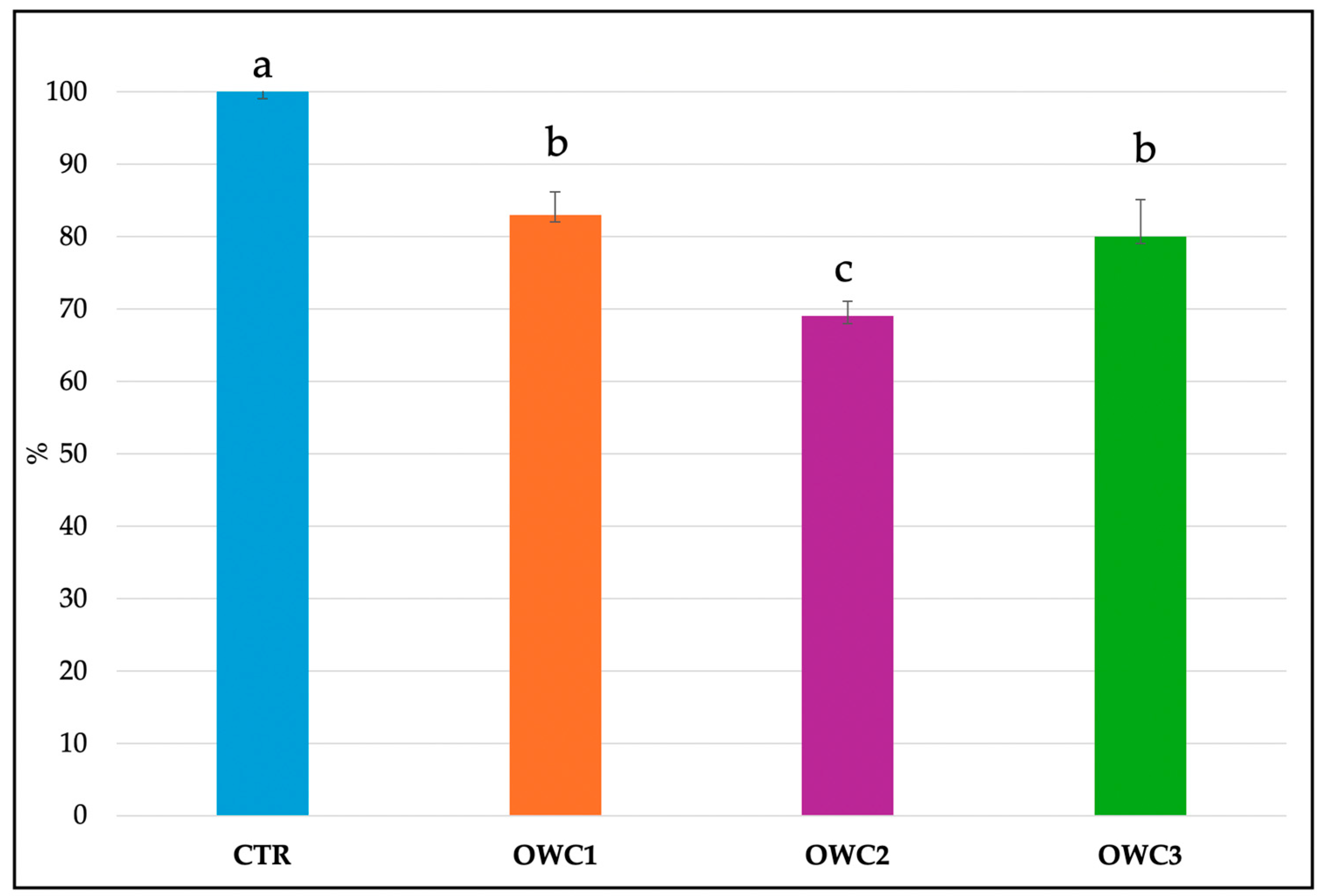

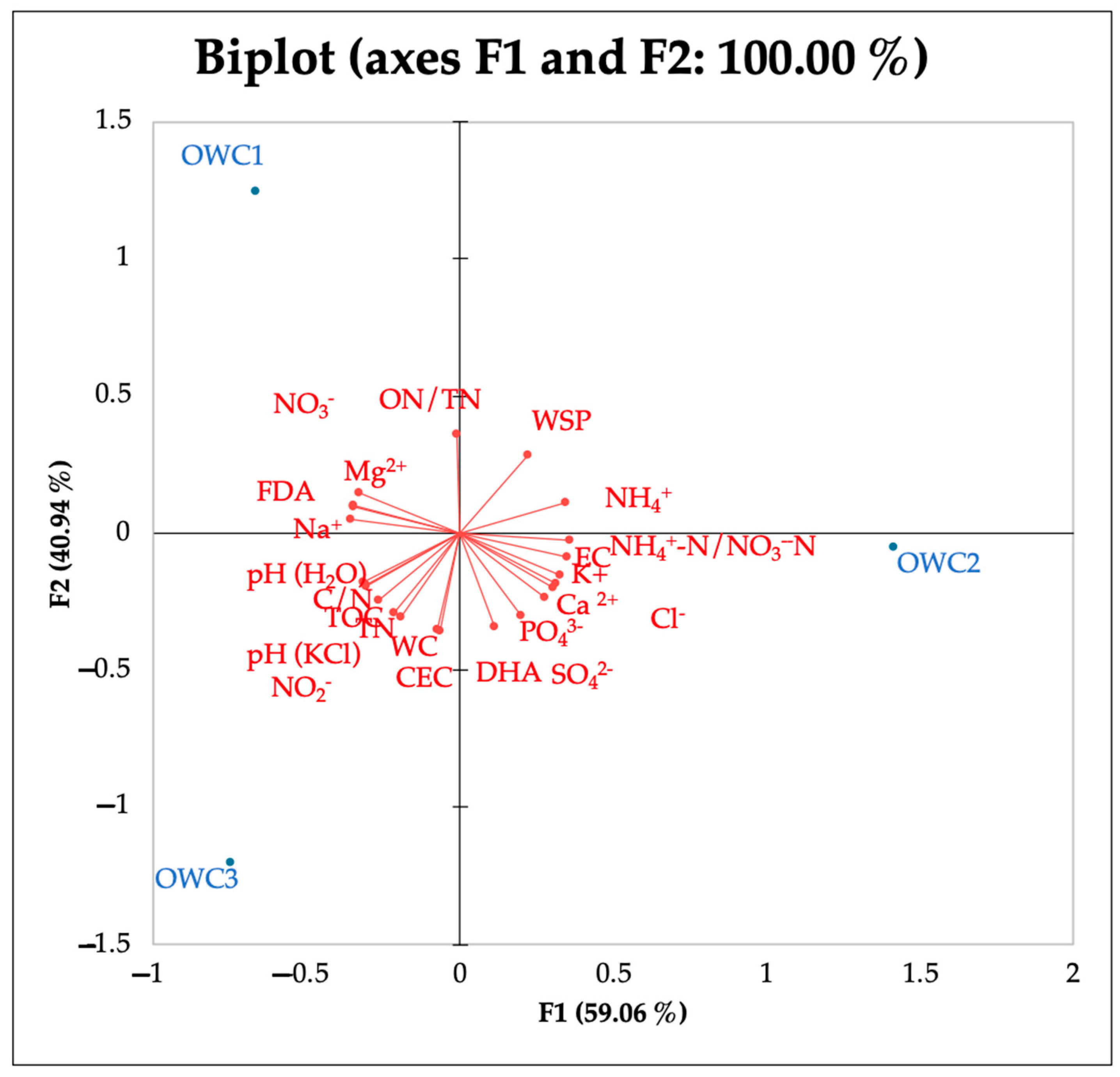
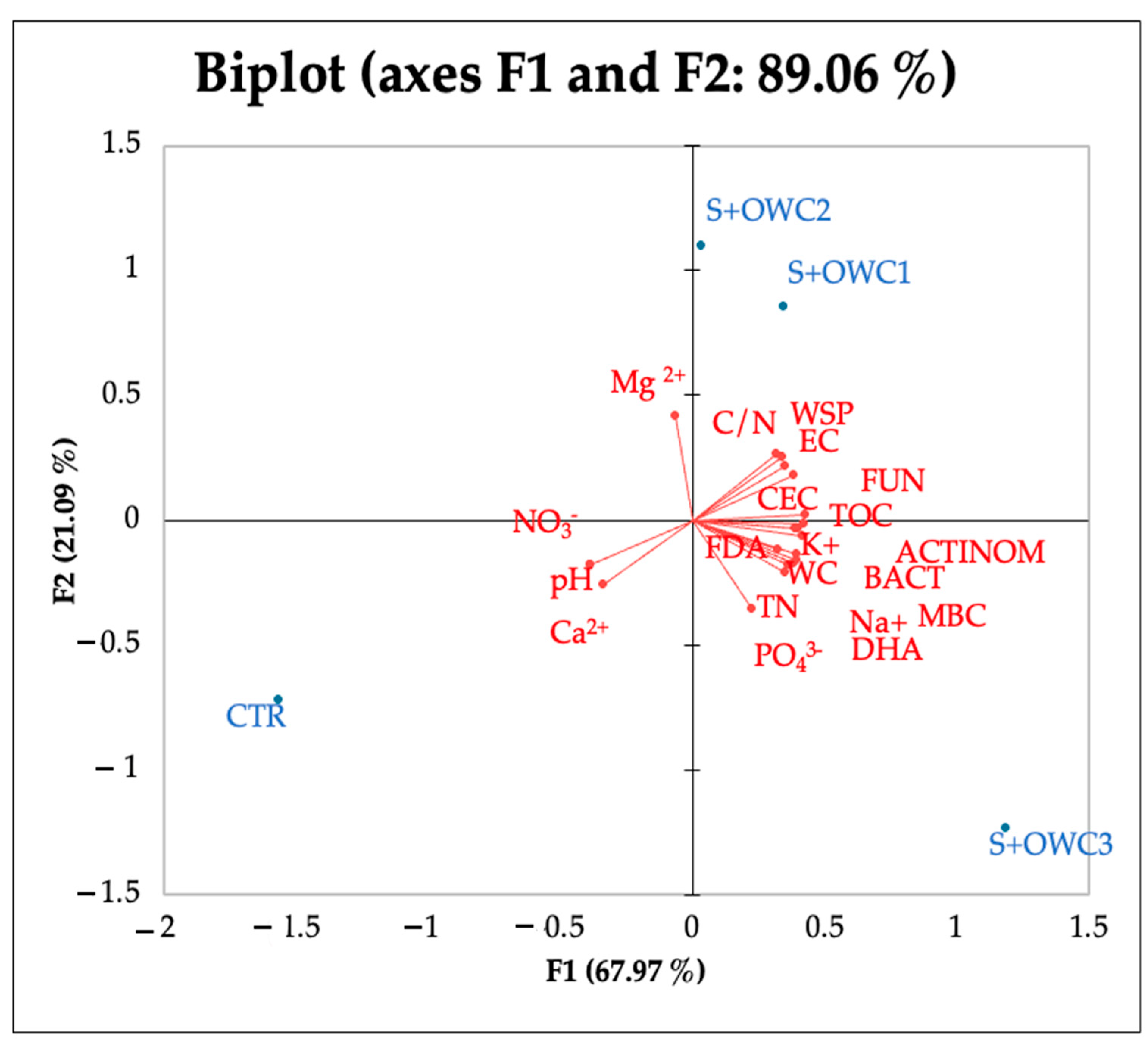
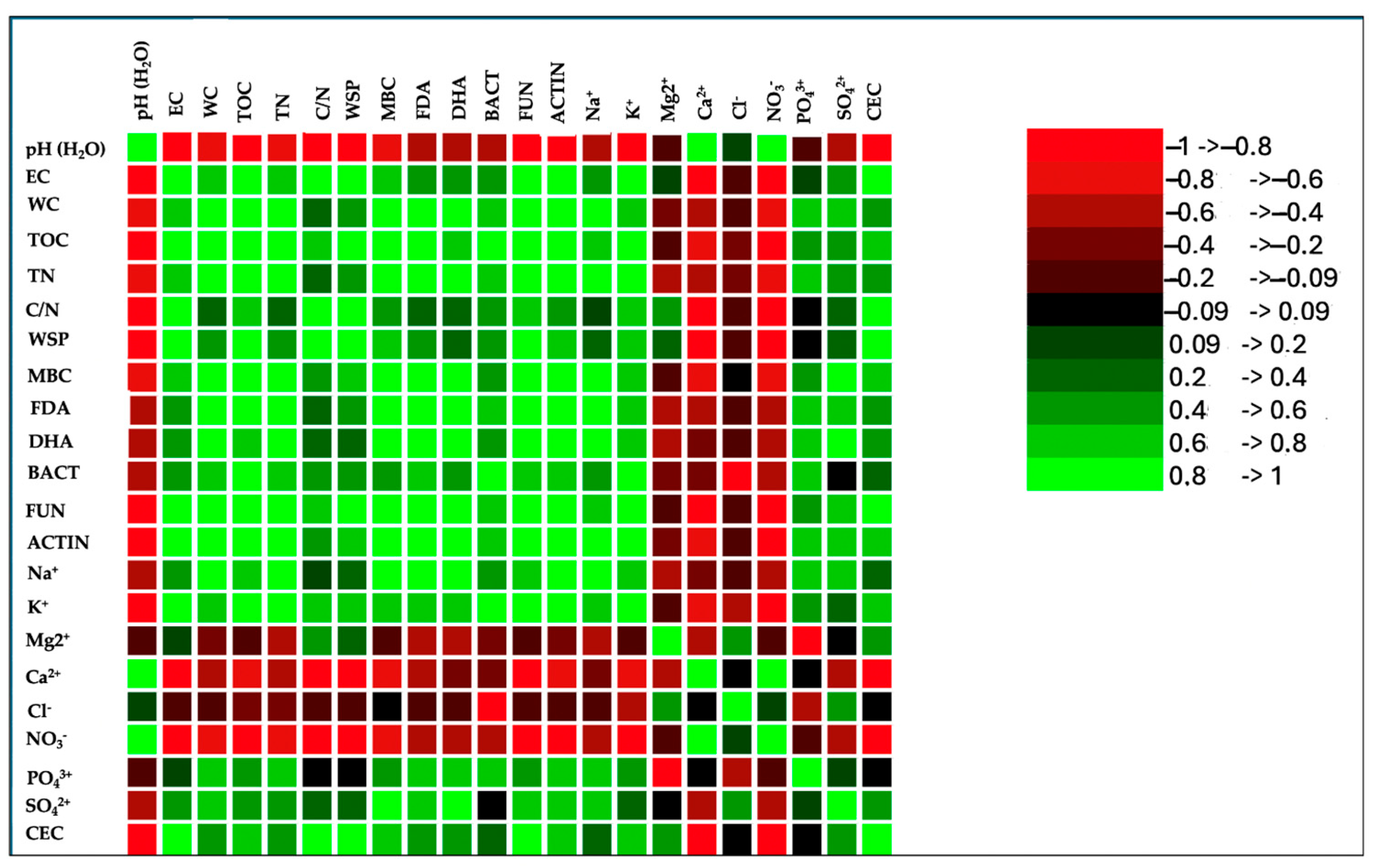
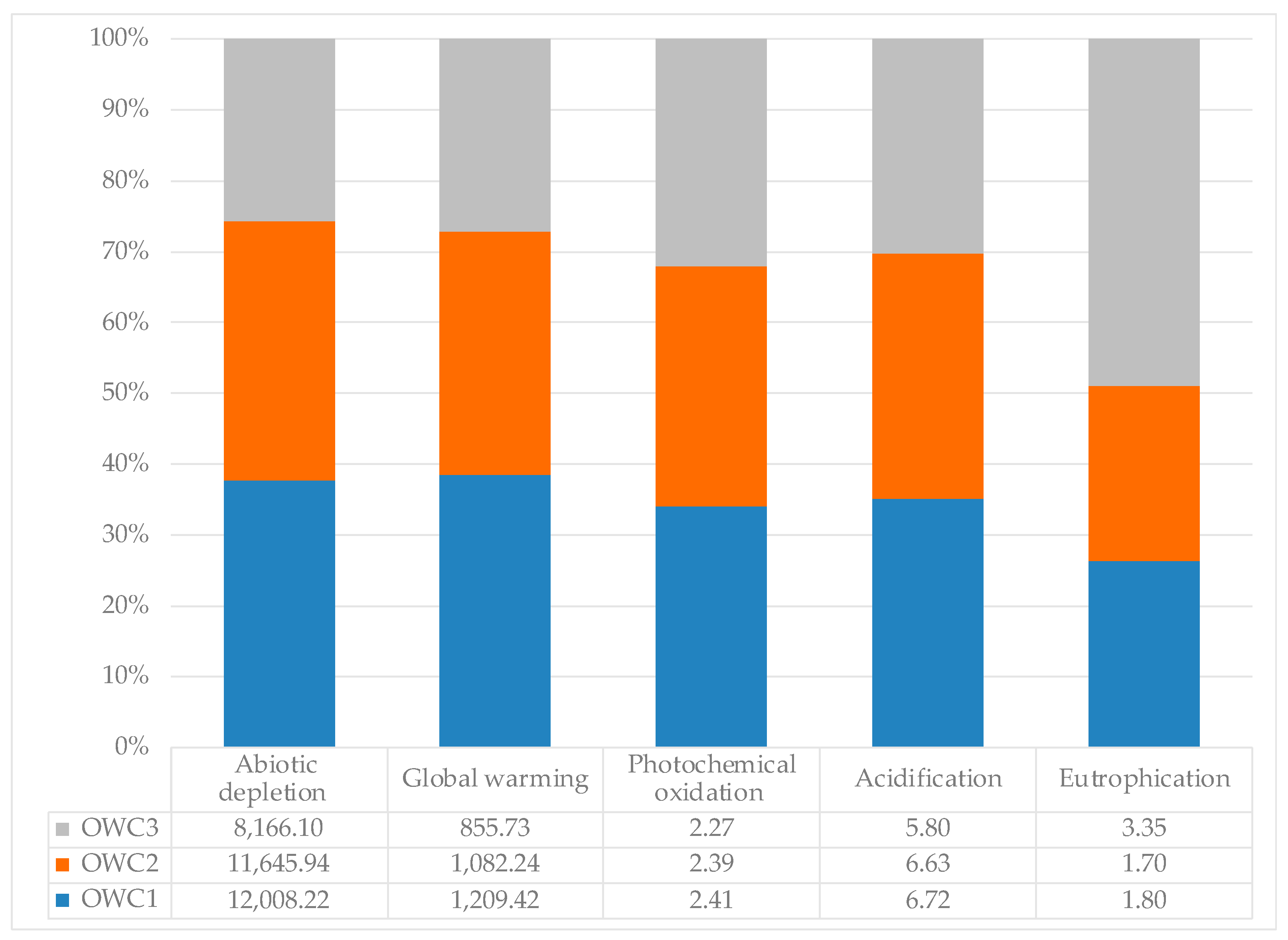
| OWC1 | OWC2 | OWC3 | |
|---|---|---|---|
| Oil mill | |||
| Electricity (kWh) | 154 | 100 | 53 |
| Water | 86 | 76 | 45 |
| Collection of crop residues | |||
| Straw (kg) | 100 | 100 | 330 |
| Olive pomace | 900 | 900 | 340 |
| Manure (kg) | 330 | ||
| Machinery (h) | 0.5 | 0.5 | 0.8 |
| Diesel and lubricant (MJ) | 3.54 | 3.54 | 4.98 |
| Electricity (kWh) | 1 | 1 | 1.24 |
| Human labor (h) | 1 | 1 | 1.1 |
| Transport | |||
| Machinery (h) | 2 | 2 | 3 |
| Diesel and lubricant (MJ) | 196 | 196 | 213 |
| Human labor (h) | 1 | 1 | 2 |
| Composting process | |||
| Water (m3) | 34 | 13 | 23 |
| Machinery (h) | 8 | 8 | 7 |
| Diesel and lubricant (MJ) | 267 | 267 | 213 |
| Electricity (kWh) | 17 | 17 | 15 |
| Human labor (h) | 6 | 6 | 4 |
| Trasport of the compost and its distribution on the field | |||
| Machinery (h) | 4 | 4 | 4 |
| Diesel and lubricant (MJ) | 426 | 426 | 426 |
| Human labor (h) | 5 | 5 | 5 |
| ID | pH (H2O) | pH (KCl) | EC | WC | TOC | TN | C/N | NH4+-N/NO3−-N | ON/TN |
|---|---|---|---|---|---|---|---|---|---|
| OWC1 | 6.44 b* ± 0.11 | 5.84 b ± 0.28 | 2.12 b ± 0.35 | 42.6 c ± 0.34 | 48.05 b ± 0.28 | 1.67 b ± 0.001 | 28.74 b ± 0.40 | 1.60 c ± 0.06 | 90.10 a ± 1.68 |
| OWC2 | 5.34 c ± 0.35 | 4.88 c ± 0.19 | 11.83 a ± 0.80 | 58.5 b ± 0.55 | 42.44 b ± 0.49 | 1.64 b ± 0.003 | 25.87 b ± 0.51 | 11.00 a ± 0.41 | 85.00 b ± 1.36 |
| OWC3 | 7.80 a ± 0.17 | 7.10 a ± 0.11 | 2.60 b ± 0.74 | 58.3 a ± 0.76 | 62.61 a ± 0.56 | 1.96 a ± 0.004 | 31.90 a ± 0.55 | 6.08 b ± 0.15 | 81.00 c ± 1.45 |
| ID | Na+ | NH4+ | K+ | Mg2+ | Ca2+ | Cl− | NO2− | NO3− | PO43− | SO42− |
|---|---|---|---|---|---|---|---|---|---|---|
| OWC1 | 1.20 a* ± 0.05 | 0.17 b ± 0.01 | 17.90 b ± 0.02 | 1.40 a ± 0.02 | 0.29 b ± 0.04 | 0.80 b ± 0.11 | 0.01 a ± 0.004 | 0.05 a ± 0.010 | 0.50 b ± 0.04 | 0.39 b ± 0.03 |
| OWC2 | 0.79 b ± 0.04 | 0.28 a ± 0.03 | 20.29 a ± 0.01 | 1.19 b ± 0.04 | 0.56 a ± 0.01 | 3.77 a ± 0.47 | 0.01 a ± 0.003 | 0.01 a ± 0.002 | 2.12 a ± 0.21 | 1.21 a ± 0.15 |
| OWC3 | 1.15 a ± 0.02 | 0.11 c ± 0.01 | 18.43 b ± 0.01 | 1.32 a ± 0.12 | 0.43 a ± 0.07 | 2.65 a ± 0.02 | 0.02 a ± 0.14 | 0.04 a ± 0.002 | 1.15 a ± 0.03 | 1.12 a ± 0.23 |
| ID | WSPs | FDA | DHA | CEC |
|---|---|---|---|---|
| OWC1 | 2.55 a* ± 0.10 | 81.12 a ± 2.16 | 39.22 b ± 1.16 | 22.95 b ± 0.86 |
| OWC2 | 2.67 a ± 0.11 | 16.55 c ± 5.21 | 80.12 b ± 3.57 | 25.13 b ± 1.03 |
| OWC3 | 1.60 b ± 0.11 | 65.60 b ± 2.21 | 89.31 a ± 4.11 | 28.81 a ± 2.81 |
| ID | pH | EC | WC | TOC | TN | C/N | WSPs |
|---|---|---|---|---|---|---|---|
| CTR | 8.50 a* ± 0.04 | 338 c ± 7.2 | 20.7 c ± 1.1 | 3.0 b ± 0.05 | 0.18 b ± 0.003 | 16.6 b ± 0.06 | 15 c ± 1.120 |
| S+OWC1 | 8.00 b ± 0.05 | 455 a ± 5.7 | 29.2 a ± 0.9 | 4.1 b ± 0.23 | 0.21 a ± 0.002 | 20.0 a ± 0.01 | 43 b ± 1.073 |
| S+OWC2 | 8.00 b ± 0.08 | 398 b ± 7.1 | 23.9 b ± 1.6 | 4.2 b ± 0.21 | 0.20 ab ± 0.001 | 21.0 a ± 0.03 | 51 a ± 1.601 |
| S+OWC3 | 8.01 b ± 0.01 | 400 b ± 3.1 | 35.2 c ± 0. 8 | 4.9 a ± 0.12 | 0.25 a ± 0.004 | 19.6 a ± 0.08 | 44 b ± 2.08 |
| ID | MBC | FDA | DHA | BACT | FUN | ACTINOM |
|---|---|---|---|---|---|---|
| CTR | 401 d* ± 8.7 | 2.9 c ± 0.05 | 19.8 c ± 0.11 | 1.3 × 105 c ± 0.21 | 4.4 × 104 c ± 0.53 | 6.1 × 104 c ± 0.47 |
| S+OWC1 | 550 b ± 4.5 | 3.5 b ± 0.02 | 24.6 b ± 0.02 | 1.4 × 105 c ± 0.19 | 1.2 × 105 b ± 1.28 | 1.5 × 105 b ± 0.22 |
| S+OWC2 | 466 c ± 4.9 | 3.1 c ± 0.01 | 20.20 c ± 0.06 | 2.0 × 105 b ± 0.13 | 1.1 × 105 b ± 0.89 | 1.2 × 105 b ± 0.27 |
| S+OWC3 | 580 a ± 8.3 | 4.1 a ± 0.05 | 28.10 a ± 0.32 | 2.4 × 105 a ± 0.11 | 1.5 × 105 a ± 0.53 | 2.0 × 105 a ± 0.13 |
| ID | Na+ | K+ | Mg2+ | Ca2+ | Cl− | NO3− | PO43− | SO42− | CEC |
|---|---|---|---|---|---|---|---|---|---|
| CTR | 0.12 c* ± 0.001 | 0.11 c ± 0.004 | 0.023 b ± 0.001 | 0.86 a ± 0.050 | 0.22 b ± 0.007 | 0.022 ± 0.0004 | 0.001 b ± 0.002 | 0.34 c ± 0.050 | 18.7 b ± 0.101 |
| S+OWC1 | 0.15 b ± 0.005 | 0.15 b ± 0.002 | 0.029 a ± 0.002 | 0.47 c ± 0.011 | 0.27 a ± 0.020 | nd | nd | 0.68 a ± 0.101 | 22.3 a ± 0.310 |
| S+OWC2 | 0.12 c ± 0.001 | 0.18 a ± 0.001 | 0.029 a ± 0.001 | 0.50 c ± 0.010 | 0.18 b ± 0.011 | nd | nd | 0.34 c ± 0.073 | 21.8 a ± 0.105 |
| S+OWC3 | 0.18 a ± 0.002 | 0.21 a ± 0.003 | 0.019 b ± 0.002 | 0.57 b ± 0.001 | 0.17 b ± 0.031 | nd | 0.005 a ± 0.011 | 0.58 b ± 0.001 | 21.3 a ± 0.001 |
| Impact Categories | OWC1 | OWC2 | OWC3 | ||||||
|---|---|---|---|---|---|---|---|---|---|
| Upstream | Core | Downstream | Upstream | Core | Downstream | Upstream | Core | Downstream | |
| Abiotic depletion | 10,763.7 | 295 | 949.5 | 10,401.7 | 294.7 | 959.5 | 7397.3 | 187.7 | 581 |
| Global warming | 1005.8 | 19.3 | 84.4 | 978.6 | 19.3 | 84.4 | 790.7 | 14.4 | 50.6 |
| Photochemical oxidation | 0.4 | 0 | 0 | 0.4 | 0 | 0 | 0.3 | 0 | 0 |
| Acidification | 6.2 | 0.1 | 0.4 | 6.1 | 0.1 | 0.4 | 5.5 | 0 | 0.3 |
| Eutrophication | 1.6 | 0 | 0.2 | 1.5 | 0 | 0.2 | 3.2 | 0 | 0.1 |
Disclaimer/Publisher’s Note: The statements, opinions and data contained in all publications are solely those of the individual author(s) and contributor(s) and not of MDPI and/or the editor(s). MDPI and/or the editor(s) disclaim responsibility for any injury to people or property resulting from any ideas, methods, instructions or products referred to in the content. |
© 2024 by the authors. Licensee MDPI, Basel, Switzerland. This article is an open access article distributed under the terms and conditions of the Creative Commons Attribution (CC BY) license (https://creativecommons.org/licenses/by/4.0/).
Share and Cite
Maffia, A.; Marra, F.; Celano, G.; Oliva, M.; Mallamaci, C.; Hussain, M.I.; Muscolo, A. Exploring the Potential and Obstacles of Agro-Industrial Waste-Based Fertilizers. Land 2024, 13, 1166. https://doi.org/10.3390/land13081166
Maffia A, Marra F, Celano G, Oliva M, Mallamaci C, Hussain MI, Muscolo A. Exploring the Potential and Obstacles of Agro-Industrial Waste-Based Fertilizers. Land. 2024; 13(8):1166. https://doi.org/10.3390/land13081166
Chicago/Turabian StyleMaffia, Angela, Federica Marra, Giuseppe Celano, Mariateresa Oliva, Carmelo Mallamaci, Muhammad Iftikhar Hussain, and Adele Muscolo. 2024. "Exploring the Potential and Obstacles of Agro-Industrial Waste-Based Fertilizers" Land 13, no. 8: 1166. https://doi.org/10.3390/land13081166
APA StyleMaffia, A., Marra, F., Celano, G., Oliva, M., Mallamaci, C., Hussain, M. I., & Muscolo, A. (2024). Exploring the Potential and Obstacles of Agro-Industrial Waste-Based Fertilizers. Land, 13(8), 1166. https://doi.org/10.3390/land13081166









